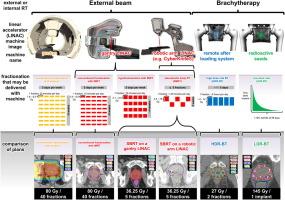Comparison of outcomes and toxicities among radiation therapy treatment options for prostate cancer |
| |
| Affiliation: | 2. Department of Data Science, Dana-Farber Cancer Institute, Boston, Massachusetts |
| |
| Abstract: | 
We review radiation therapy (RT) options available for prostate cancer, including external beam (EBRT; with conventional fractionation, hypofractionation, stereotactic body RT [SBRT]) and brachytherapy (BT), with an emphasis on the outcomes, toxicities, and contraindications for therapies. PICOS/PRISMA methods were used to identify published English-language comparative studies on PubMed (from 1980 to 2015) that included men treated on prospective studies with a primary endpoint of patient outcomes, with ⩾70 patients, and ⩾5 year median follow up. Twenty-six studies met inclusion criteria; of these, 16 used EBRT, and 10 used BT. Long-term freedom from biochemical failure (FFBF) rates were roughly equivalent between conventional and hypofractionated RT with intensity modulation (evidence level 1B), with 10-year FFBF rates of 45–90%, 40–60%, and 20–50% (for low-, intermediate-, and high-risk groups, respectively). SBRT had promising rates of BF, with shorter follow-up (5-year FFBF of >90% for low-risk patients). Similarly, BT (5-year FFBF for low-, intermediate-, and high-risk patients have generally been >85%, 69–97%, 63–80%, respectively) and BT + EBRT were appropriate in select patients (evidence level 1B). Differences in overall survival, distant metastasis, and cancer specific mortality (5-year rates: 82–97%, 1–14%, 0–8%, respectively) have not been detected in randomized trials of dose escalation or in studies comparing RT modalities. Studies did not use patient-reported outcomes, through Grade 3–4 toxicities were rare (<5%) among all modalities. There was limited evidence available to compare proton therapy to other modalities. The treatment decision for a man is usually based on his risk group, ability to tolerate the procedure, convenience for the patient, and the anticipated impact on quality of life. To further personalize therapy, future trials should report (1) race; (2) medical comorbidities; (3) psychiatric comorbidities; (4) insurance status; (5) education status; (6) marital status; (7) income; (8) sexual orientation; and (9) facility-related characteristics. |
| |
| Keywords: | Comparative effectiveness research Prostate cancer Technology Personalized medicine Radiation therapy Quality of life Clinical trials Brachytherapy Proton therapy |
| 本文献已被 ScienceDirect 等数据库收录! |
|

